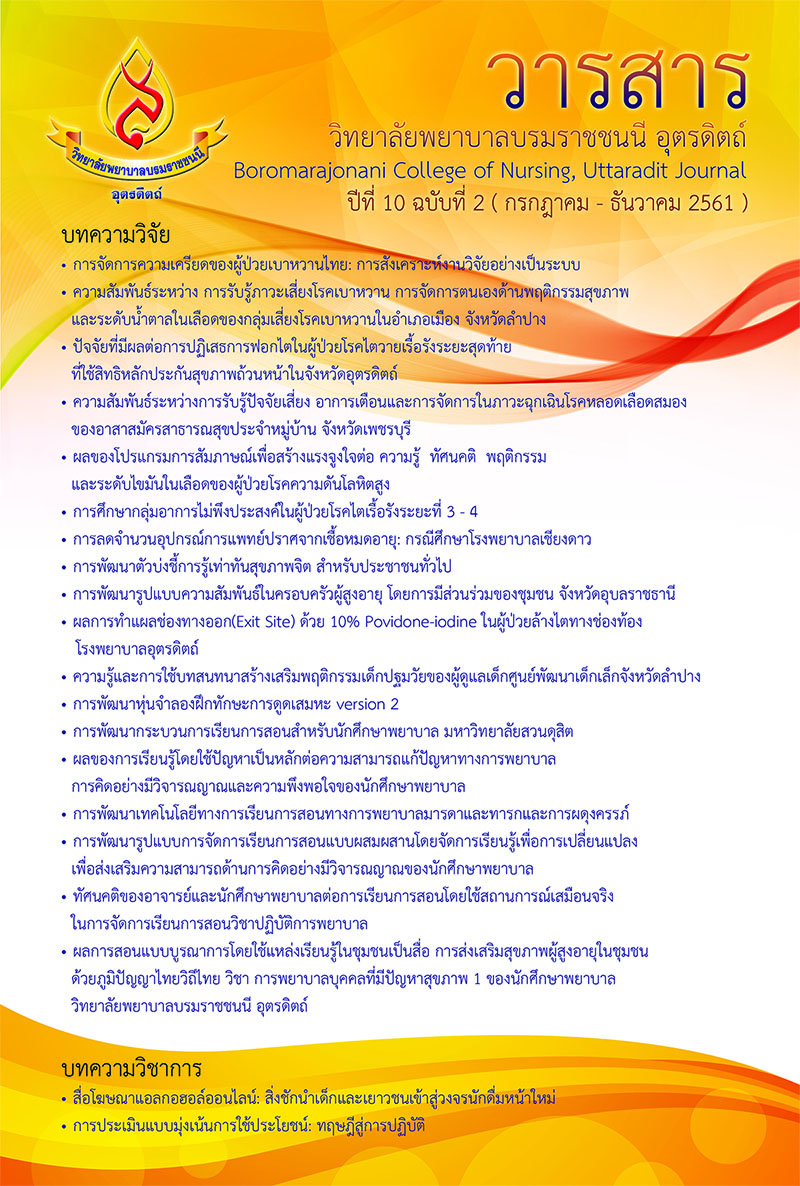Relationship between Perceived Risk Factors, Warning Signs and Emergency Management of Stroke among Village Health Volunteer in Phetchaburi Province
Main Article Content
Abstract
This study was to investigate the relationships regarding perceived risk factors, warning signs, and emergency management in of stroke for village health volunteer in Phetchaburi province. The sample consisted of 97 village health volunteers. The instruments for data collecting were included the demographic data form, the perceived risk factors form, the perceived warning signs form, the emergency management interview form, and FAST meaning evaluation form. Data were analyzed by using descriptive statistics, Pearson’s product moment correlation coefficient, and Chi-square. The study showed that the village health volunteers had perceived risk factors at a good level with 8.19 from 10 score. Overall perceived warning signs were at a moderate level with 8.29 out of 12 score. Moreover, the findings revealed that the subjects answer correct telephone number for emergency line with 1669 correctly in emergency management of stroke. The samples gave a meaning of FAST in each alphabets correctly with average score of 2.90 out of 4. The perceived risk factors were not related to emergency management of stroke. The perceived risk factors were positively related to perceived warning signs of stroke with a statistical significance (r = .005, p < .01) and perceived warning signs were positively related to emergency management of stroke with a statistical significance (r = .008, p < .01). From the study findings, the village health volunteer showed good level of stroke knowledge. So, village health volunteer who had good perception of risk factors will be also good in warning signs followed with good emergency management of stroke.
Article Details
Journal of Nursing and Health Science Research attribution-non-commercial 4.0 international (CC BY-NC 4.0). For more detail please visit https://creativecommons.org/licenses/by-nc/4.0/ . The ideas and opinions expressed in the Journal of Nursing and Health Science Research are those of the authors and not necessarily those of the editor .
References
2. Bloom, B. (1956). Bloom’s taxonomy of learning domains. Retrived October 2, 2017, from www.nbna.org/files/Blooms%20Taxonomy%20of%20Learning.pdf.
3. Bureau of Non Communicable Diseases, Department of Disease Control, Ministry of Public Health (2017). Pocket book for risk assessment of ischemic heart disease and stroke for village health volunteer (2nd edition), 1-36. Bangkok: WVO office of Printing Mill. (in Thai)
4. Chiangthong, K. (2011). Relationships between the health belief model, warning signs perception and management of stroke behavior in the risk group of stroke, Doi Saket District, Chiang Mai Province. (Master of public health thesis), Chiang Mai University. (in Thai)
5. Jauch, E.C., Saver, J.L. & Adams, H.P., et al. (2013). Guidelines for the early management of patients with acute ischemic stroke: A guideline for healthcare professionals.The American Heart Association. Stroke, 44 (3), 870-947.
6. Kumpangkaew, K., Somboontanont, W. & Leelahakul, V. (2015). Relationships between perceived risk, Perceived warning signs and self-care behavior in older adults at risk of cerebrovascular disease. Nursing Journal of the Ministry of Public Health, 25(2), 40 - 56. (in Thai)
7. Nualnetr, N, et al. (2008). A study of village health volunteers’ knowledge and daily living behavior on the stroke. KKU Research Journal, 13(7), 807-818. (in Thai)
8. Phudhichareonrat, S. (2011). Neuroanatomy and function of intracranial and extracranial vessels. Retrived February 16, 2017, from https:// www.phn.bangkok.go.th/index.php?option=com_docman&task.
9. Primary Health Care Division. (2017). People health information system. Retrived September 21, 2017, From https://www.thaiphc.net/thaiphcweb/index.php?r=site/main. (in Thai)
10. Seesawang, J., & Thongtang, P. (2016). Post-stroke depression among older adult stroke survivors. Boromarajonani College of Nursing, Uttaradit Journal, 8(2), 73-85. (in Thai)
11. Shigehatake, Y., et al., (2014). Stroke education using an animated cartoon and a manga for junior high school students. Journal of Stroke and Cerebrovascular Diseases, 23(6), 1623-1627.
12. Strategy and Planning Division, Ministry of Public Health. (2017). Public health statistics A.D.2017. Nonthaburi, Thailand: Strategy and Planning Division. (in Thai)
13. Thonghong, A., Thepsittha, K. & Chogpiriyaanan, P. (2012). Chronic disease surveillance report, 2012. Retrieved June 21, 2017, from: https://www.boe.moph.go.th/ files/report/20140109_40197220.pdf.
14. Tippayanate, N. & Chanabutr, W. (2016). Knowledge of stroke risk factors and warning signs: a case study of the Stroke education program in Mahasarakham factory. Retrieved June 21, 2017, from: https://www.niems.go.th/th/Upload/File/255911291539072135_dE7hVSOZkKEUPi6z.pdf.
15. World Health Organization. (2017). Stroke, cerebrovascular accident. Retrieved October 13, 2017, from: https://www.who.int/topics/cerebrovascular_accident/en/.

